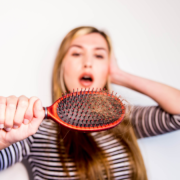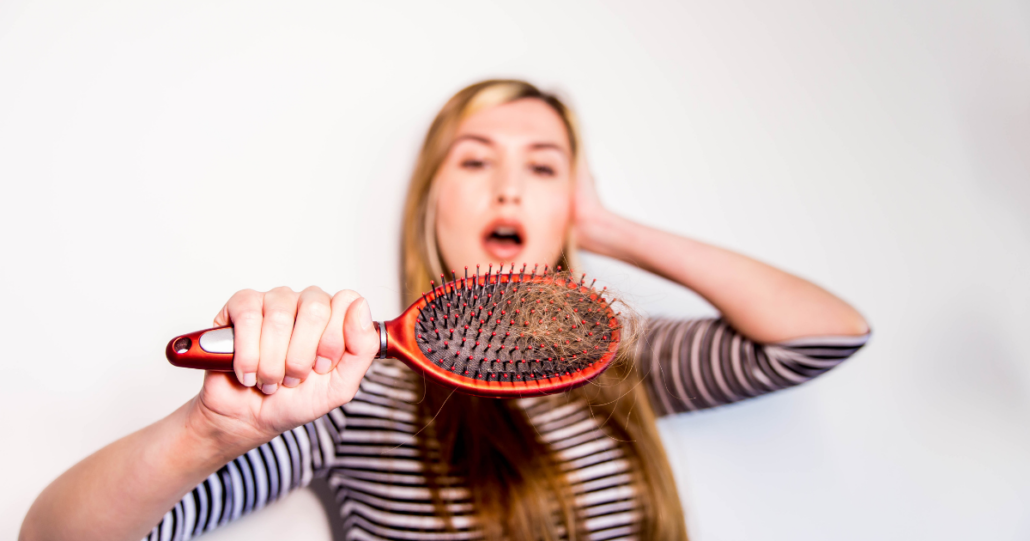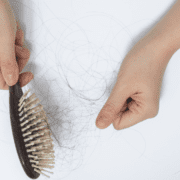A New Purpose for an Old Hair Loss Therapy
By Kyleen Davis
If you are like many of our patients, you probably read the New York Times. Chances are that you or someone you know came across a recent article about a new and inexpensive treatment that can help grow your hair back. This article, entitled, An Old Medicine Grows New Hair for Pennies a Day, was published in the late summer of last year and quickly began trending. Many of you have brought up this article during your office visits to discuss hair loss. Others may be curious about the validity of these claims. What are these new therapies? And do they actually work?
About Hair Loss
Unfortunately, hair loss is an extremely common condition, affecting an estimated 50 million men and 30 million women in the United States. The American Academy of Dermatology reports that over half of men will have moderate to severe hair loss by the age of 50. Similarly, more than 50% of women will develop some form of female pattern hair loss by age 79.
Treatments for Hair Loss
The good news is that there are many treatment options available for patients who are struggling with hair loss. Determining the type of hair loss is crucial to tailor the treatment plan to the patient’s specific needs. In dermatology, we can diagnose the type of patient hair loss with a careful history, physical examination, and close-up inspection of the hair follicles, a process known as trichoscopy. Lab work or scalp biopsy may also be ordered to confirm the diagnosis. While multiple types of hair loss, or alopecia, exist, androgenetic alopecia (male and female pattern hair loss) is the most common cause of hair loss in the United States.
Androgenetic alopecia (AGA) has traditionally been treated with topical minoxidil (Rogaine) since the Food and Drug Administration (FDA) approved the 5% solution for men in 1988 and the 2% solution for women in 1991. Prior to its approval, minoxidil’s side effect of hypertrichosis (excessive hair growth) was found incidentally when patients taking this medication at doses of 10-40 mg daily for high blood pressure started to grow more hair. For many years the oral form of minoxidil was avoided as a therapeutic option for hair loss due to potential adverse effects and because topical minoxidil was effective.
New Type of Hair Loss Treatment
That is, until recently when an Australian physician named Dr. Rodney Sinclair conducted a study showing that a fraction of the standard dose of minoxidil could help grow hair with less risk of side effects. Since that time, multiple studies have been conducted on the use of oral minoxidil in the treatment of hair loss. Most studies have demonstrated that low-dose oral minoxidil (LDOM) at doses ranging from 0.25 mg to 2.5 mg per day was generally safe and highly efficacious for the treatment of alopecia, especially for AGA. While a significant portion of patients taking LDOM developed hair growth of the sides of the face and temples, this did not typically result in discontinuation of the medication.
There are several treatments for androgenetic alopecia, including other oral agents, topical therapy, platelet rich plasma (PRP), low level laser therapy, and vitamin supplements. Many of them work well together and each has a specific risk benefit profile that should be considered for an individual patient. The great news is that thinning hair can be improved!
References
American Academy of Dermatology. (2022). What is male pattern hair loss, and can it be treated? Available online at: https://www.aad.org/public/diseases/hair-loss/treatment/male-pattern-hair-loss-treatment.
Beach, R., McDonald, K., & Barrett, B. (2021). Low-dose oral minoxidil for treating alopecia: A 3-year North American retrospective case series. Journal of the American Academy of Dermatology, 84(3), 761-763.
Fabbrocini, G., Cantelli, M., Masara, A., Annunziata, M., Marasca, C., & Cacciapuoti, S. (2018). Female pattern hair loss: A clinical, pathophysiologic, and therapeutic review. International Journal of Women’s Dermatology, 4(4), 203-211.
Heymann, W. (2022). Coming full circle (almost): low dose oral minoxidil for alopecia. American Academy of Dermatology, Dermatology World Insights and Inquiries, 4(1). Available online at: https://www.aad.org/dw/dw-insights-and-inquiries/archive/2022/low-dose-oral-minoxidil-alopecia.
Jimenez-Cauhe, J., Saceda-Corralo, D., Rodrigues-Barata, R., Moreno-Arrones, O., Ortega-Quijano, D., Fernandez-Nieto, D., Jaen-Olasalo, P., & Vano-Galven, S. (2020). Safety of low-dose oral minoxidil treatment for hair loss. A systematic review and pooled-analysis of individual patient data. Journal of Dermatology Research and Therapy, 33(6), e14106.
Kolata, G. (2022). An old medicine grows new hair for pennies a day, doctors say. The New York Times. Available online at: https://www.nytimes.com/2022/08/18/health/minoxidil-hair-loss-pills.html.
Pfizer (Pharmacia & Upjohn Company). (2015). Loniten ™ minoxidil tablets, USP, package insert. Available online at: https://www.accessdata.fda.gov/drugsatfda_docs/label/2015/018154s026lbl.pdf.
Rajab, F. (2022). Low-dose oral minoxidil for hair growth. Dermatology Times, 43(11).
Ramos, P., Sinclair, R., Kasprzak, M., & Miot, H. (2020). Minoxidil 1 mg oral versus minoxidil 5% topical solution for the treatment of female pattern hair loss: A randomized clinical trial. Journal of the American Academy of Dermatology, 82(1), 252-253.
Randolph, M. & Tosti, A. (2021). Oral minoxidil treatment for hair loss: A review of efficacy and safety. Journal of the American Academy of Dermatology, 84(3), 737-746.
Rhodes, T., Girman, C., Savin, R., Kaufman, K., Guo, S., Lilly, F., Siervogel, R., & Chumlea, W. (1998). Prevalence of male pattern hair loss in 18-49 year-old men. Dermatologic Surgery, 24(12), 1330-1332.
Sharma, A., Michelle, L., Juhasz, M., Ramos, P., Mesinkovska, N. (2020). Low dose oral minoxidil as treatment for non-scarring alopecia: a systematic review. International Journal of Dermatology, 59(8), 1013-1019.
Sinclair, R. (2018). Female pattern hair loss: A pilot study investigating combination therapy with low-dose oral minoxidil and spironolactone. International Journal of Dermatology, 57(suppl 65). Available online at: https://www.researchgate.net/profile/Rodney-Sinclair/publication/321756113_Female_pattern_hair_loss_A_pilot_study_investigating_combination_therapy_with_low-dose_oral_minoxidil_and_spironolactone/links/5a81583fa6fdcc0d4bacaa59/Female-pattern-hair-loss-A-pilot-study-investigating-combination-therapy-with-low-dose-oral-minoxidil-and-spironolactone.pdf?origin=publication_detail.














